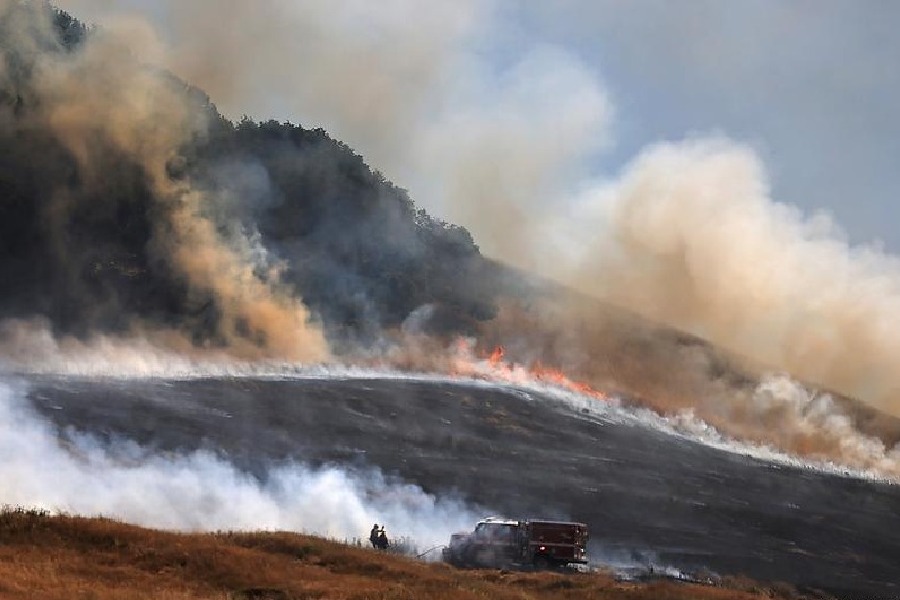El Nino — a natural, cyclical climate pattern that causes hot weather — has heightened the risk of food, water and health security in some parts of the world, scientists have warned.
The World Meteorological Organization confirmed El Nino's return last month after three stubborn years of La Nina, the opposite effect.
The El Nino weather pattern is 95% likely to prevail until February 2024, a US government weather forecaster said on Thursday.
Compounded with the effects of global warming, this spell of El Nino could trigger localized drought and hunger events as well as the increased spread of vector-borne diseases.
"El Nino does not mean a year with more disasters than others, globally," said Walter Baethgen, a scientist at Columbia University's International Research Institute for Climate and Society. He said it can, however, cause severe localized effects in different parts of the world.
Warming vs. cooling
El Nino and La Nina are the two parts of a weather pattern called the El Nino-Southern Oscillation (ENSO), an irregular but periodic variation in wind patterns and sea surface temperatures over the tropical eastern Pacific Ocean.
El Nino represents the warming phase of ENSO, while La Nina represents its cooling phase. In El Nino years, the temperature spikes by around 0.1 degree Celsius (about 0.2 Fahrenheit) and falls by about the same amount in La Nina years. During the fluctuation, the phenomenon often goes through a neutral phase.
The two individual periods last several months at a time and occur every few years with varying frequency and intensity. This pattern affects the climate in most of the tropic and subtropical regions.
Record temperatures more likely
The Earth has hit record temperatures repeatedly in recent years and months — the average temperature for July 2023 is confirmed to be the highest on record , according to the World Meteorological Organization, at 0.72 degrees Celsius warmer than the 1991-2020 average for July.

People around the world have been forced to cool off any way they can, including this man at an urban beach in Madrid Deutsche Welle
Such events are more likely to occur in this cycle of El Nino, said Chris Hewitt, head of climate services at the WMO.
"Estimates show us that there is a 66% chance that global temperate can shoot over 1.5 degrees Celsius from the pre-industrial era," he said.
Hewitt emphasized that the full impact of El Nino will be evident in 2024, adding that the Earth could experience its hottest year ever in the next half decade.
Localized threats to food security
Baethgen said it's important for climate scientists to take El Nino into account while making global predictions over the course of this spell to better prepare for potential knock-on effects like drought and threats to food security.
With experts warning that El Nino could cause problems for the harvest of rice crops, many countries in South and Southeast Asia are already taking measures to conserve stocks. India, for example, has banned the export of many varieties of rice, while parts of Indonesia are planning for an early harvest.
Although predicting disasters with certainty can be difficult, we already know that some parts of the tropics and subtropics have always been hit harder during El Nino years. For example, parts of Ethiopia experience drought during every El Nino year, while some areas along the Andes Mountain range in South America see intense drought and flooding when the weather pattern hits.
El Nino also often brings a spate of dangerous heat waves to South Asia. Identifying these sorts of patterns in vulnerable regions can help scientists better predict disasters.
"That's going to help us take anticipatory actions," said Baethgen.
Effect of El Nino on health
The sudden changes in heat observed during El Nino years can affect overall health and manifest as heat exertion, stroke or even death.
"Heat waves kill more people than any other severe weather in the US. Last year, there were 60,000 more deaths related to heat in Europe," said Gregory Wellenius, head of the Center for Climate and Health at Boston University.
Sudden hot weather certainly affects the physiology of the human body, and some studies have shown a correlation between heat waves and mental health problems. But experts say the most common negative health impact ignited by the heat is the outbreak of vector-borne diseases like malaria and dengue.

Hot weather can negatively affect the physiology of the human body, leading many to seek shade during the hottest part of the day Deutsche Welle
Madeleine Thomson, head of climate impacts and adaptation at the charity Wellcome, said many of these sorts of outbreaks have been observed during previous El Nino years.
"In Kenya, for example, during the 1997-1999 El Nino, the increase in mosquito breeding was crazy. There were widespread malaria outbreaks in East Africa," she said, adding that similar patterns were observed during the last El Nino spell in 2015 and 2016.
Thomson said El Nino typically manifests through these types of geographically localized events, rather than massive global disasters.
A tandem with climate crisis
El Nino is a natural phenomenon that has been occurring for centuries, but its effects have been stronger in recent decades. While there is no proven link, experts fear this could be related to climate change.
Thomson said meteorological organizations around the world should study the impact of weather on health, to better prepare the public to face both challenges in the coming years.










